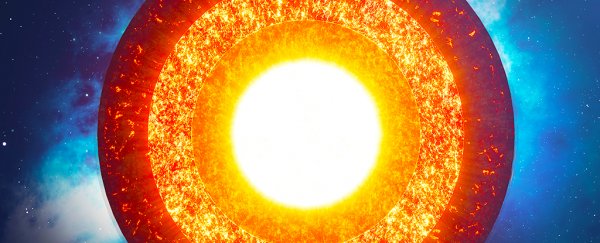By listening to the muffled sound of our planet's groaning guts, geologists have revealed that Earth's core could be coated in a thick layer of metallic dust; a scene dismissed in the past as implausible by many researchers.
Contradictions between seismic data and existing models of our planet's molten insides have been hard to solve. So geologists are now reconsidering the existence of a fuzzy zone of mineral 'snow' gently falling from the bottom of the outer core.
Not only could this tell us a few things about our planet's geology, it might help to explain how other planets like ours form.
"It's sort of a bizarre thing to think about," says geochemist Nick Dygert, who currently works at the University of Tennessee in the US.
"You have crystals within the outer core snowing down onto the inner core over a distance of several hundred kilometres."
Decades of studies on sound waves bouncing around inside our planet show they slow down in a weird way when they pass through the lower layers of the outer core.
Weirder yet, the data suggests there's a marked difference in how the waves are transmitted on either side of the core, slowing down more across the western surface than the eastern.
It's almost as if the core is covered in something viscous, and that coating isn't even all the way around.
With a small team of geologists from The University of Texas at Austin and a physicist from Sichuan University in China, Dygert has showed how a viscous slush made of an iron alloy could do a better job of explaining why the echoes of earthquakes rippling through our planet don't sound quite as they ought to.
A similar idea was first proposed by the Russian geologist Stanislav Iosifovich Braginskii back in the early 1960s, and has been explored over the decades to explain convection processes transporting heat from our planet's core.
This 'snow-capped core' model has been one of those neat ideas that never really caught on, popping up from time to time in an attempt to describe features not just our own world's core, but the cold, still heart of Mars.
Unfortunately the kinds of pressures and temperatures expected at the boundary of the highly dense inner core and its surrounding outer core won't permit for tiny particles of minerals to crystallise.
At least, that's what everybody thought. Dygert and his colleagues used recent mineral physics data to show how compounds made of iron, silicon and oxygen could in fact solidify out of a liquid solution at the right temperatures.
The process would work more or less like the mineral crystallisation found closer to the surface, only under much higher pressures and hotter temperatures.
"The Earth's metallic core works like a magma chamber that we know better of in the crust," says Jung-Fu Lin from The University of Texas at Austin.
Not only would this iron snowfall create a material that would slow down seismic waves in just the right way, it could also explain why the core isn't a perfect sphere.
Differences in the crust we see as continents influence how energy radiates out into space. For example, deep sections of the crust under Central America do an exceptional job of pulling heat from the core.
These differences could reasonably add up to variations in the way the iron drifts solidify around the core, making sound waves slow down more in the western hemisphere than the eastern.
"The inner-core boundary is not a simple and smooth surface, which may affect the thermal conduction and the convections of the core," says Sichuan University physicist Youjun Zhang.
Aeons of iron crystals piling up around the core like snow across a field certainly has a poetic feel to it. But it's also a weather report that raises questions of what our core looked like in the ancient past, and could resemble in the far future.
Geoscientist Bruce Buffet from the University of California, Berkley, who wasn't involved with the study, thinks that models like these could help to answer questions on how our world – and rocky bodies like Earth – might have formed.
"Relating the model predictions to the anomalous observations allows us to draw inferences about the possible compositions of the liquid core and maybe connect this information to the conditions that prevailed at the time the planet was formed," says Buffet.
"The starting condition is an important factor in Earth becoming the planet we know."
Time will tell whether the iron-snow model of our core might have merit. It's not just of academic interest either; we're desperate to know how the engines deep under the surface churn out a magnetic field, feed volcanoes, and produce earthquakes.
It's not like we can go down there to take a look. But if we listen carefully, we just might make out the muffled sounds of our planet's heart gathering dust as it slowly ages.
This research was published in Journal of Geophysical Research: Solid Earth.
